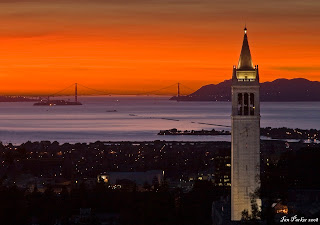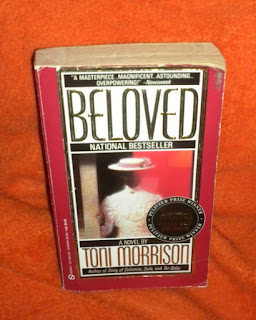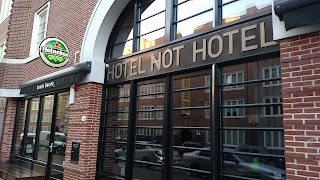Adventures in the MFA-Lite: Great Novels You Always Meant to Read
Through high school, college and my shamanic studies, I was a mediocre student. It's not that I didn't have the interest or the capacity to learn but it seemed like what was lacking was the military expression of high expectations: from my teachers, from my fellow students, and, from the worst offender, myself. Maybe the environment, for a combination of reasons, wasn't conducive for high expectations; maybe I just lacked drive for years as my missing soul parts were treading water, looking for a home. My experience at Berkeley has helped change the narrative. More specifically, literature, which I am studying, has helped change my self-talk, my self-narrative; has given it a makeover, with a syntax fresh and a pool of vocabulary that is gleaming and cool. And a voice that is less afraid.
For years, I had always wanted to apply to an MFA in Creative Writing. Google Excel Spreadsheets attest to that fact; I had color-coordinated boxes denoting schools with their presumed degrees of difficulty and perceived reptutations. I had joined social media chat groups, where students, ten, fifteen years my junior fretted over everything from the statement of purpose (make it sound professional but not wooden!) to studying for the GRE's. I took the GRE's (twice), the second time scoring in the 94th percentile for verbal comprehension and a respectable 4.5 out of a 6.0 scale in essay writing. I was on my way, and all this, mind you, was just for applying.
MFA programs in Creative Writing have exploded in the last 20 years. According to the Association of Writers and Writing Programs, the number of MFA programs had more than tripled between 1994 and 2014 (from 64 to 229 and that does not include an additional 152 MA programs in writing). In fact, there are emerging academic studies tracking the phenomenal growth of MFA programs themselves; storytelling is increasingly seen as one of America's biggest exports. Many folks have valid criticisms over this. Naysayers see the American workshop style as a way of cementing capitalist beliefs and white superiority. American fiction has relied on the adage of "show, don't tell" whereas the truth is that members of unrecognized communities have a need to tell their stories, to let readers know who they really are.
I didn't really care about the politics, I cared about the title. I so badly wanted to be welcomed by the academy, to glide into an elite program like Pitt, WUSTL, or Minnesota, schools where the average acceptance rate hovers around 3%, more selective than many med schools.
After 6, 7 years I came to the adult realization that a.) I didn't want to leave California, and b.), I didn't want to go into debt. There is funding to be had for studying creative writing but I would have to attend school in parts of Appalachia or the Midwest for a full-residency education, an advertising ploy by red-state deans to draw in some of the creative class members who Richard Florida is always saying will single-handedly turn a region's economy around. Accepting such an honor would mean giving up my job, apartment and partner, and at age 38, I found this terrifying. Luckily, I found a Post-Baccalaureate Program in Creative Writing at University of California, Berkeley, Extension whose evening classes fit snugly alongside my day job. So far, I've taken 3 classes and worked my fanny off to secure three A's. Essentially, the Berkeley program is an MFA-Lite and I couldn't be happier.
My most recent class, Great Novels You Always Meant to Read, was taught by Thais Miller, an NYU graduate and published author who knows her subject matter inside-out and delivers it with unflagging enthusiasm. Here's a rundown of the novels we covered in my most recent class
The Adventures of Tom Sawyer by Mark Twain: Easily one of my favorite books and one that I first read with Mr. Tart in 7th grade English class. "Tom Sawyer" is breezy, irreverent, and humorous, it's a book that serves as a bridge between American Romanticism and American Realism. Level of difficulty (on a scale of 1 through 5): 1.5. Some readers get snagged on the poor southern slang of Mr. Twain's cast of characters. Recommended for audio listening, something fun and light for a long car ride.
Mrs. Dalloway by Virginia Woolf. Mrs. Woolf explores the precariousness of London life after the utter devastation of World War I through a stream-of-consciousness style. There was a point or two where I was almost ready to give up on this novel (but I'm so glad I persevered!). Readers may fault her for seemingly never coming up for air. On that note, Woolf's uses oceanic imagery as her way to explain everything from human emotion to modern street life and does so in the most awe-inspiring way. She has these sublime observations and a total knack for knowing and showing both male and female desire. Level of difficulty: 3.5 (some readers may begrudge her for a lack of chapter breaks which was an experimental technique of the Modernist movement).
Giovanni's Room by James Baldwin, an African-American literary prodigy who grew up in Harlem but moved to France. In many ways, Giovanni's Room, the 1956 novel by James Baldwin, was our first gay novel and it's still amazingly relevant, as well as extremely well-written with a high, exact (and exacting), poetic voice. What's more is that Baldwin, in this work, focused solely on white characters of American, Italian and French origin (He basically said that it would be too much to bite off had the author tackled the race and sexuality questions together in a breakthrough novel). The main theme of this masterpiece is how shame, tradition and loneliness dictate so many of the personal and societal decisions made in the years following World War II. A must read! Level of difficulty: 2.0.
As I Lay Dying by William Faulkner. Groundbreaking and odd, Faulkner started writing this on Friday, October 25th, one day after Black Thursday of the Wall Street Crash of 1929. Using and refining symbolism, Faulkner tells the story of the Bundrens, a family grappling with the death of their matriarch, Addie. Told through multiple-first-person-points-of-view, it's a treatise on the movement from the swinging, individualistic 1920s to the more communitarian 1930s. Level of difficulty: 4.5. Take a class to understand this one!
Beloved by Toni Morrison. A novel that I'm still currently reading, Beloved is about the spectre of slavery and the lengths a mother will go to protect the freedom of her children. Language: lyrical, surprising. In many ways this is a ghost story. Level of difficulty: 3.5.
I think the great thing about studying literature, as a writer, is that with this sheer exposure and close study of all these different styles and movements, you are given permission to experiment. I've wasted so many years waiting for permission in so many different areas that when it comes organically from a writer you worship, it feels like the most natural thing in the world. The writer just gives the inspiration, of course. We have to give ourselves permission.
For years, I had always wanted to apply to an MFA in Creative Writing. Google Excel Spreadsheets attest to that fact; I had color-coordinated boxes denoting schools with their presumed degrees of difficulty and perceived reptutations. I had joined social media chat groups, where students, ten, fifteen years my junior fretted over everything from the statement of purpose (make it sound professional but not wooden!) to studying for the GRE's. I took the GRE's (twice), the second time scoring in the 94th percentile for verbal comprehension and a respectable 4.5 out of a 6.0 scale in essay writing. I was on my way, and all this, mind you, was just for applying.
MFA programs in Creative Writing have exploded in the last 20 years. According to the Association of Writers and Writing Programs, the number of MFA programs had more than tripled between 1994 and 2014 (from 64 to 229 and that does not include an additional 152 MA programs in writing). In fact, there are emerging academic studies tracking the phenomenal growth of MFA programs themselves; storytelling is increasingly seen as one of America's biggest exports. Many folks have valid criticisms over this. Naysayers see the American workshop style as a way of cementing capitalist beliefs and white superiority. American fiction has relied on the adage of "show, don't tell" whereas the truth is that members of unrecognized communities have a need to tell their stories, to let readers know who they really are.
I didn't really care about the politics, I cared about the title. I so badly wanted to be welcomed by the academy, to glide into an elite program like Pitt, WUSTL, or Minnesota, schools where the average acceptance rate hovers around 3%, more selective than many med schools.
After 6, 7 years I came to the adult realization that a.) I didn't want to leave California, and b.), I didn't want to go into debt. There is funding to be had for studying creative writing but I would have to attend school in parts of Appalachia or the Midwest for a full-residency education, an advertising ploy by red-state deans to draw in some of the creative class members who Richard Florida is always saying will single-handedly turn a region's economy around. Accepting such an honor would mean giving up my job, apartment and partner, and at age 38, I found this terrifying. Luckily, I found a Post-Baccalaureate Program in Creative Writing at University of California, Berkeley, Extension whose evening classes fit snugly alongside my day job. So far, I've taken 3 classes and worked my fanny off to secure three A's. Essentially, the Berkeley program is an MFA-Lite and I couldn't be happier.
My most recent class, Great Novels You Always Meant to Read, was taught by Thais Miller, an NYU graduate and published author who knows her subject matter inside-out and delivers it with unflagging enthusiasm. Here's a rundown of the novels we covered in my most recent class
The Adventures of Tom Sawyer by Mark Twain: Easily one of my favorite books and one that I first read with Mr. Tart in 7th grade English class. "Tom Sawyer" is breezy, irreverent, and humorous, it's a book that serves as a bridge between American Romanticism and American Realism. Level of difficulty (on a scale of 1 through 5): 1.5. Some readers get snagged on the poor southern slang of Mr. Twain's cast of characters. Recommended for audio listening, something fun and light for a long car ride.
Mrs. Dalloway by Virginia Woolf. Mrs. Woolf explores the precariousness of London life after the utter devastation of World War I through a stream-of-consciousness style. There was a point or two where I was almost ready to give up on this novel (but I'm so glad I persevered!). Readers may fault her for seemingly never coming up for air. On that note, Woolf's uses oceanic imagery as her way to explain everything from human emotion to modern street life and does so in the most awe-inspiring way. She has these sublime observations and a total knack for knowing and showing both male and female desire. Level of difficulty: 3.5 (some readers may begrudge her for a lack of chapter breaks which was an experimental technique of the Modernist movement).
Giovanni's Room by James Baldwin, an African-American literary prodigy who grew up in Harlem but moved to France. In many ways, Giovanni's Room, the 1956 novel by James Baldwin, was our first gay novel and it's still amazingly relevant, as well as extremely well-written with a high, exact (and exacting), poetic voice. What's more is that Baldwin, in this work, focused solely on white characters of American, Italian and French origin (He basically said that it would be too much to bite off had the author tackled the race and sexuality questions together in a breakthrough novel). The main theme of this masterpiece is how shame, tradition and loneliness dictate so many of the personal and societal decisions made in the years following World War II. A must read! Level of difficulty: 2.0.
As I Lay Dying by William Faulkner. Groundbreaking and odd, Faulkner started writing this on Friday, October 25th, one day after Black Thursday of the Wall Street Crash of 1929. Using and refining symbolism, Faulkner tells the story of the Bundrens, a family grappling with the death of their matriarch, Addie. Told through multiple-first-person-points-of-view, it's a treatise on the movement from the swinging, individualistic 1920s to the more communitarian 1930s. Level of difficulty: 4.5. Take a class to understand this one!
Beloved by Toni Morrison. A novel that I'm still currently reading, Beloved is about the spectre of slavery and the lengths a mother will go to protect the freedom of her children. Language: lyrical, surprising. In many ways this is a ghost story. Level of difficulty: 3.5.
I think the great thing about studying literature, as a writer, is that with this sheer exposure and close study of all these different styles and movements, you are given permission to experiment. I've wasted so many years waiting for permission in so many different areas that when it comes organically from a writer you worship, it feels like the most natural thing in the world. The writer just gives the inspiration, of course. We have to give ourselves permission.










Comments
Post a Comment